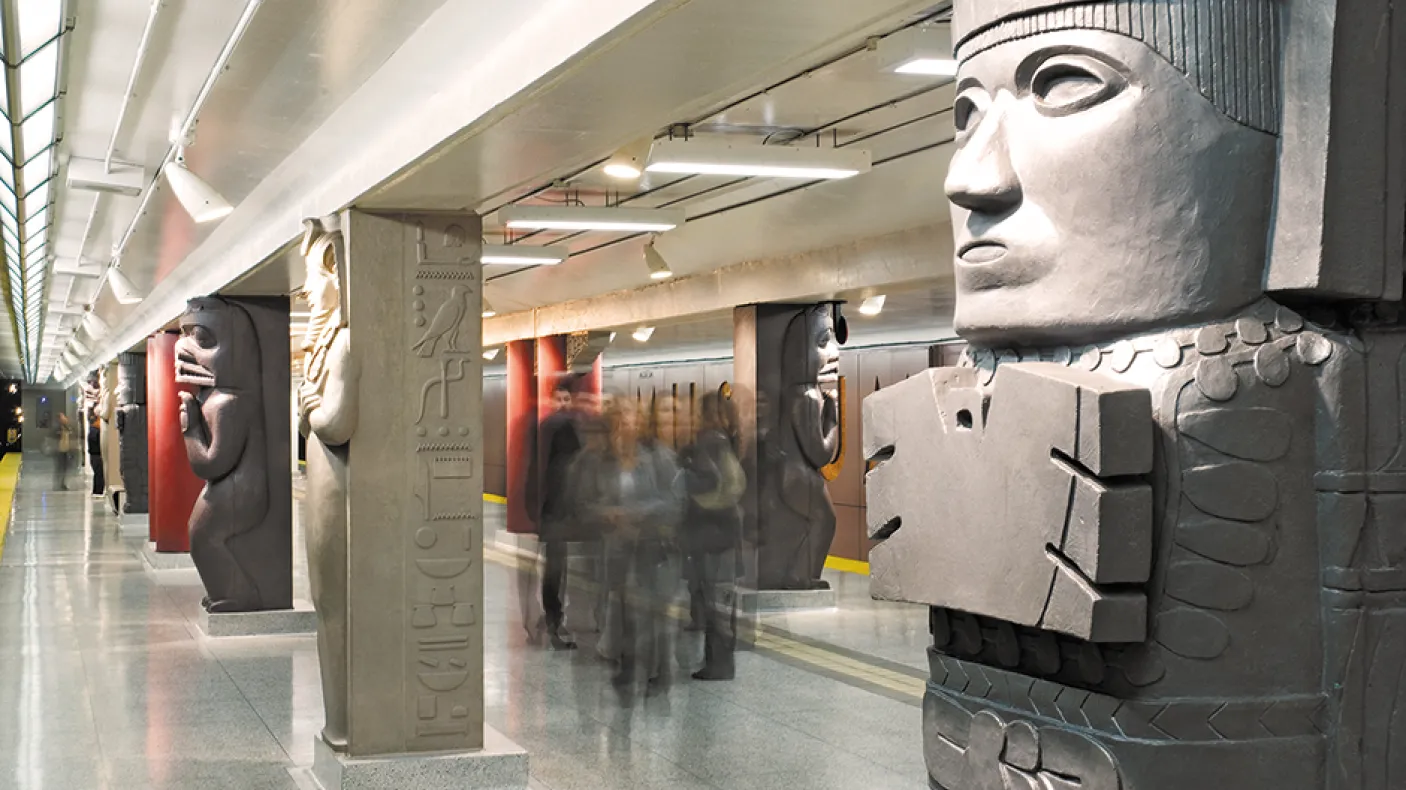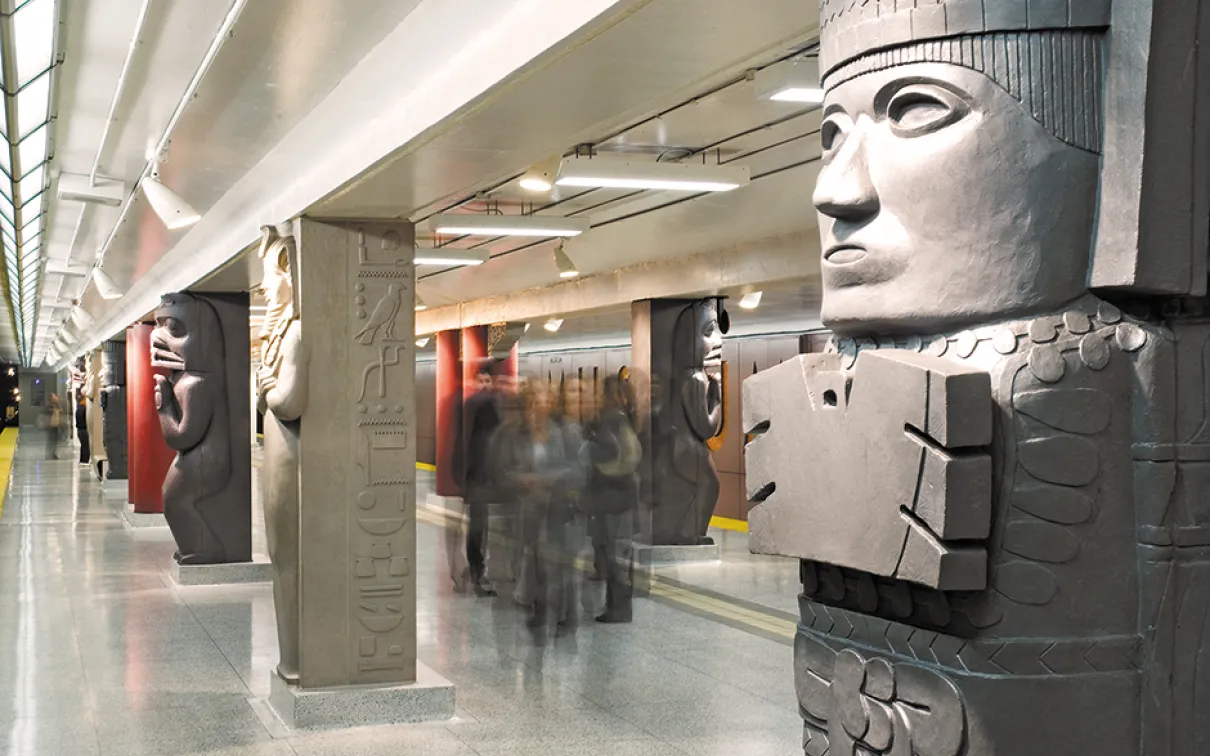Art on the tracks
The story behind the sculptures at Museum subway station
Published
Categories
Author
On April 11, 2008, Mayor David Miller
On April 11, 2008, Mayor David Miller officially opened the renovated Museum subway station. Diamond Schmitt Architects designed the new station using artifacts from the ROM and the Gardiner Museum as inspiration for the columns used on the subway platform. Those involved from the ROM included Kenneth Lister, who chose the Wuikinuxv Nation House post, Roberta Shaw, in creating the composite Egyptian column, Paul Denis, who worked on the Greek Doric column, and Sara Irwin, for the Chinese column. Helen Haines, at Trent University, was consulted for the replica of the column from a temple in the ancient Toltec capital of Tula. Completing the overall design, the walls were given a contemporary look, framing the embedded hieroglyphic.
Today, a decade later, the columns have withstood the test of time and still look fresh and new. They not only beautify and animate the station but also inform people about the treasures that await them at street level.
Osiris Plaster
In temples dedicated to deceased kings, rulers were often featured as columns in the form of Osiris, the god of the dead and eternity. The upper half of the pilaster, featuring the royal headdress, the crook, and the flail, identifies a king. The wrapped lower half identifies the god Osiris, who is typically depicted as a mummy in Egyptian mythology. The hieroglyphic inscription on the back of the pillar is copied from a relief found in the Egyptian gallery at the Royal Ontario Museum.
Toltec Warrior Column
This column is a replica of one of four warrior columns located atop a temple in the ancient Toltec capital of Tula, central Mexico. The Toltecs dominated this area from around 900 to 1150 AD, influencing the cultures of the Maya and Aztecs. The figure on the column is believed to represent the warrior-god Tlahuizcalpantecuhtli in the guise of the evening star, Venus, which is often associated with warfare in Mesoamerican cultures.
Wuikinuxv First Nation House Post
This column is modelled after a house post from the Wuikinuxv Nation at Rivers Inlet in British Columbia. The original post supported one end of a home’s massive roof beam. The post was carved from a single cedar log, and the bear is a traditional family crest figure that identified the home’s family and their status. Acquired by the ROM after the house had been abandoned and dismantled, the original artifact can be found in the Daphne Cockwell Gallery dedicated to First Peoples art & culture.
Chinese Forbidden City Columns
These columns are based on the columns surrounding the Hall of Perfect Harmony in the Forbidden City, the palace of the Chinese emperors of the Ming and Qing dynasties. Like most Chinese imperial palace and temple buildings, the columns are painted red, a colour that traditionally represents happiness and good fortune to the Chinese. The ROM houses a full-scale reconstruction of a corner of a large palace hall in imperial style of the Qing dynasty.
Greek Doric Columns
From the time of its inception in ancient Greece to present day, the Doric column has remained an important structural and decorative architectural component. The fluted white double columns are derived from the columns used in ancient Greek temples. Doric columns are characterized by gradually tapered shafts that stand directly on the floor or foundation of the temple. The shaft is made from a series of stone drums placed one on top of the other.
Hieroglyphs in the Track Wall
The inscription contained within the letters on the track walls is from a limestone relief from the tomb of an ancient Egyptian nobleman by the name of Met-jet-jy, dating to c. 2300 BCE. The original artifact is housed in the Egyptian gallery at the ROM.
The inscription reads:
I was loved by my father, honoured and praised by my mother. I gave them a proper burial—by royal decree because I was honoured by the king—so that they could praise the god forever. I was a good son from my childhood until their demise, never causing them anger. Moreover, my opinion was considered in every royal project.
Next time you’re on your way to the ROM, get off at the Museum subway station and start your visit early!
The Arts on Track Initiative
The Arts on Track initiative was generously supported by the Toronto Foundation, an independent, charitable foundation committed to improving the quality of life in Toronto by connecting philanthropy to community needs and opportunities. The Toronto Foundation thanks its donors, the Government of Ontario and Toronto Transit Commission for their dedication to Arts on Track.


